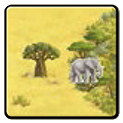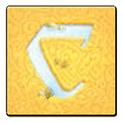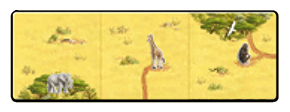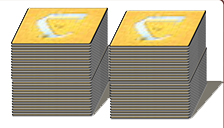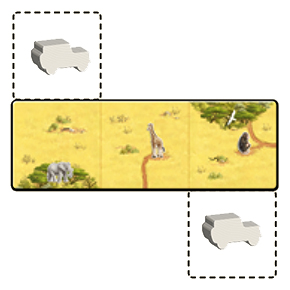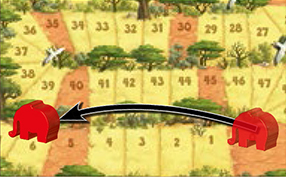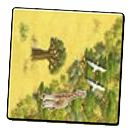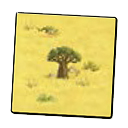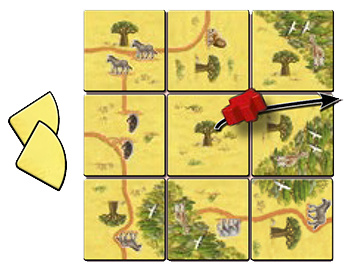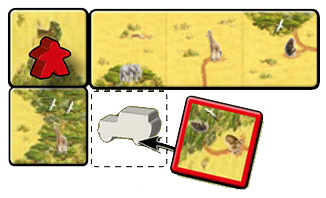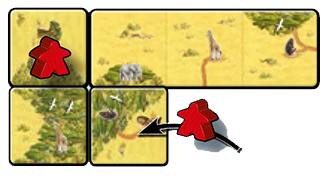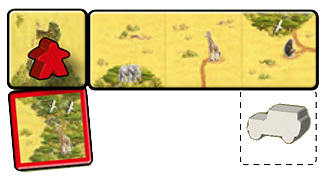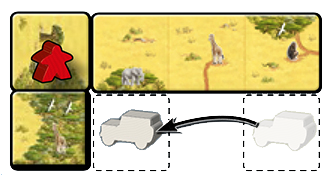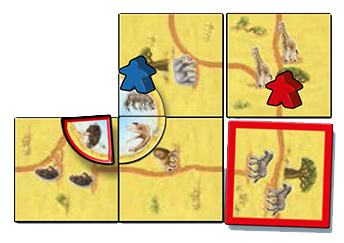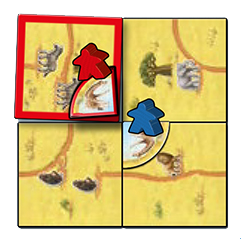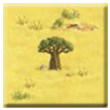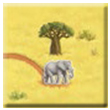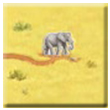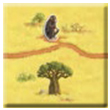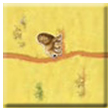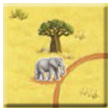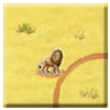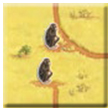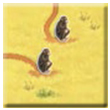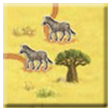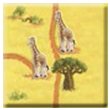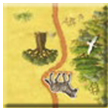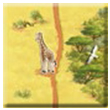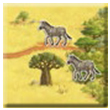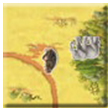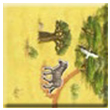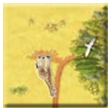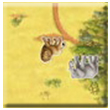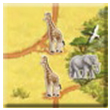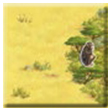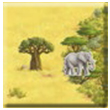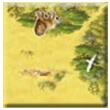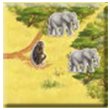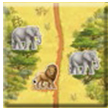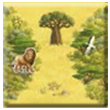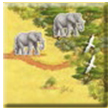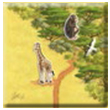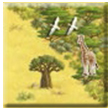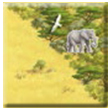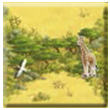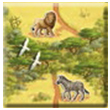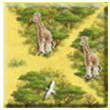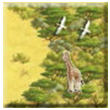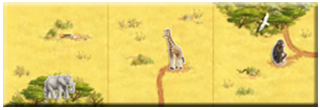Sandbox
General info and comments
Originally released by Hans im Glück in 2018.
Africa swelters under the blazing sun, but an adventure on the savanna beckons! Monkeys swing in the trees, lions repose in the shade, and the ground shakes under the thunderous footfalls of elephants. While animals one and all gather at the watering holes, trek out into the bush, lie in wait, and see the majesty of nature unfold!
Overview and goal of the game
Players take turns placing land tiles, expanding the savanna and discovering bush, animal trails, and baobab trees. You place meeples in the bush or on animal trails and complete them to score points for the different animals present, and lay meeples on baobab trees to draw new animal tiles. Animal tiles can score additional points or can be used to dig watering holes in the savanna. Players score points throughout the game as well as at the end of the game. The player with the highest score after final scoring wins.
Components and setup
Components
- 72 Landscape tiles depicting the savanna landscape, animal trails, baobab trees, and the bush where animals congregate.
- 1 start tile with the size of three land tiles.
- 50 animal / watering hole tiles depicting the five different large animals. Each animal is represented on ten tiles. Four animal tiles can be connected to create a watering hole.
- Scoreboard
- 5 scoring markers showing 50 and 100
- 30 meeples, six in each of the following colors: yellow, red, green, blue and black
- 5 elephants, one in each player's color
- 2 white ranger vehicles - these are two neutral figures referred to as "rangers" throughout the rules. The don't belong to any player.
Preparation
Shuffle all 72 land tiles, and place them facedown in stacks that are easily accessible to all players. [1]
Place the start tile in the middle of the table and place the rangers in the spaces indicated in the illustration below.
Place the scoreboard off to the side of the play area. Place the score markers next to the it.
Shuffle all 50 animal tokens and distribute two to each player. Each player puts them face up in front of them. Shuffle the rest of them and put them aside, face down. [2]
Each player chooses a color and takes the six meeples and one elephant of that color to form their personal supply. Place each player‘s elephant on the 0 space. Return all unused meeples and elephants to the box.
Gameplay
Carcassonne Safari is played in turns, in clockwise order. Starting with the youngest player, the active player follows these steps in the order listed below, after which the next player takes a turn, and so on. Below is a brief description of the actions you will take on your turn and the different features on the land tiles.
The animal trails
1. Placing a land tile with an animal trail
If you draw a tile with an animal trail, you must place it such that it continues the existing landscape (including any savanna, animal trails, or bush). [3]
2. Placing a meeple on an animal trail
3. Scoring an animal trail
An animal trail is completed when both ends are closed by bush or savanna, or when it loops back onto itself by connecting to the other end. When the trail is completed, it is scored. If one of your meeples is on a trail when it scores, you will score points from it.
You score points based on the number of different animals present on the animal trail. The number of points scored is shown below, as well as on the scoreboard.
The total number of animals on the trail does not matter, only how many different animals are present. After scoring, return your meeple from the trail to your supply.
Placing additional animals
Before you would score points from an animal trail, you may add one animal tile from your supply to that trail. The animal tile must be an animal that is not already present on that trail.
Players track their scores using the elephants placed on the scoreboard at the start of the game. When you score points, move your elephant forward that many spaces. If your elephant passes the 0 space on the scoreboard, take a scoring marker and place it with the "50" side up in front of you. If your elephant passes the 0 space again, flip the scoring marker over to the "100" side.
Discard all animal tiles that were placed on the trail faceup. If a player would draw a new animal tile but there are none left in the supply, shuffle the discarded tiles facedown to create the new supply.
The Bush
1. Placing a land tile
2. Placing a meeple
3. Scoring a feature
A bush is completed when it does not have any open sides or gaps. When a bush is completed, it is scored. If one of your meeples is in the bush when it scores, you will score points from it. The points scored from animals in a bush are the same as those scored from
an animal trail (see table below). Additionally, each bird (![]() ) above the bush is worth 1 point.
) above the bush is worth 1 point.
After scoring a bush, return your meeple from the bush to your supply.
Placing additional animals
Before you would score points from a bush, you may add one animal tile from your supply on that bush. The animal tile must be an animal that is not already present in that bush, and the animal tile is discarded after the bush is scored.
The Baobab Tree
1. Placing a land tile
2. Placing a meeple
3. Scoring a feature
When all eight spaces around a baobab tree have tiles placed on them, return your meeple from that tree to your supply, then draw two additional animal tiles from the supply and place them faceup in front of you. You do not score any points from the baobab tree.
Interim rule - note on interim rules
{{{rules}}}
Ranger car
There are two ways to move the Ranger, but this is dependent on whether the tile being placed is in a location where the Ranger is already located. One of them provides points (see option A below), the other does not (option B).
Option A
A1. Placing a Land tile
A2. Placing a meeple
A3. Scoring
Option B
B2. Not placing a meeple
B3. Scoring
The player gains no points.
Note: In one turn you can move only one Ranger. If you removed the Ranger from the board (A1) by placing a tile on its place, you can only move that one to another location, even if you do not place a meeple on the tile Two Rangers cannot be placed on the same space.
Waterhole
Animal tokens can be used not only to boost score but also to create or expand waterholes in the savanna.
Placing a Land tile
Place a drawn tile according to the standard rules.
Create or expand a waterhole
Create a waterhole
Instead of placing a meeple on the newly placed tile, a player can create a (new) waterhole. To do this, the player places one animal token from their supply in an empty corner of any tile (not necessarily the one just placed). An empty corner is one with just savanna (small patches of grass or shrubs are not an obstruction) - not bush. The corner of the animal token must always fit the corner of the tile. Next, the player must put a meeple on this waterhole when starting it, so cannot start a waterhole without having an available meeple.
The player immediately receives 3 points when creating a new waterhole.
Expanding a waterhole
Instead of placing a meeple on a newly placed tile, the player can expand an existing waterhole. The player places an animal token in the empty corner of any tile (ie Savanna) so it is adjacent to a previously placed waterhole token.
Note: No more than one animal token of the same species can be in the same waterhole. When expanding a waterhole by placing an adjacent animal token it must be a different species to one already present.
The player scores points depending on which animal token it is for that waterhole:
- 1st animal token: 3 points
- 2nd animal token: 4 points
- 3rd animal token: 5 points
- 4th animal token: 6 points
Special case
A player can create a new waterhole facing (diagonally) an existing one. Because animal tokens are not touching each other at this point, the player can put a meeple there. When the waterhole is finished, there will be two meeples on it. Both will score points. In that case there can be two of the same species in one waterhole.
Interim rule - note on interim rules
{{{rules}}}
Completing waterhole
After placing the fourth (last) animal token, the waterhole is finished. It's owner gains 3 points and returns the meeple to their resources.
If two players have meeples on this waterhole, both get 3 points.
If both meeples belong to the same player, that player only gets 3 points.
Summary
Placing a Land tile
- You must place your drawn tile in such a way that it continues the landscape and the illustration.
- In some very rare cases, it may be impossible to place the tile. In those cases, simply return the tile to the box and draw a new one.
- If a player places the tile where a Ranger is located, the player moves the Ranger to their supply.
Placing a meeple
- You may place a meeple on the Land tile you’ve just placed.
- If the meeple is placed on a baobab, the player receives two animal tokens.
- If the player does not place a meeple, the player can start building a waterhole. Player immediately gains 3 points if he does.
- If the player does not place a meeple, the Ranger can be moved to another location.
Scoring a feature
- Scoring always occurs at the end of a player’s turn. At that moment, each player with a meeple in a scored feature earns points. After each scoring, any scored meeples are returned to your supply.
- Removing Ranger from the board grants 3 points (by placing tile in place where Ranger figure is).
- Completed paths are counted, according to the number of species on it.
- Completed bush is counted, according to the number of species on it plus 1 point for every bird symbol.
- Completed baobab grants 2 animal tokens.
- Completed waterhole grants 3 points.
- If there are multiple meeples in a single scored feature, the player with the most meeples is awarded full points and all other players receive nothing. When more than one player has the most meeples in a scored feature, the tied players all score full points.
Game end and final scoring
The game ends immediately after the turn of the player who placed the last tile. Then, players proceed to a final scoring, after which the winner will be known.
Once the game is over, all meeples still in play are scored:
- Each incomplete path and bush are worth 1 point per animal and bird symbol (individual species are not taken into consideration),
- Each animal token in the player's supply is worth 1 point,
- Meeples placed on incomplete baobab are worth nothing,
- Meeples placed on incomplete waterholes are worth nothing.
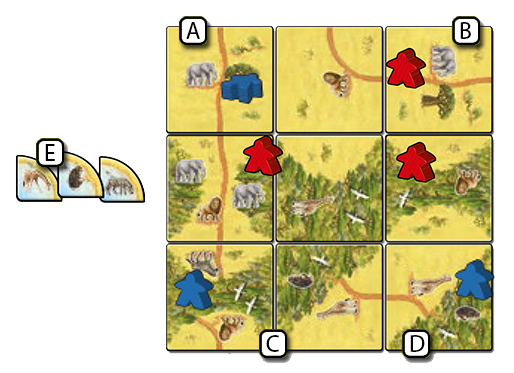
A: Blue does not get points for meeple on baobab.
B: Red gets 2 points (two animals on path).
C: Red and Blue own meeples in bush. Because Red has majority in this feature, only Red receives points - 4 points for animal icons and six for birds, 10 in total.
D: Blue receives 2 points for ape and bird in bush.
E: Red receives 3 points for animal tokens in their supply.
Once the final score is known, the winner is the player with the most points. The rules do not include tiebreakers. That is, rules explaining the situation when two or more players share the same score at the end of the game.
Special cases
Multiple meeples on the same feature
It is forbidden to put a meeple on an already occupied feature. It may happen that after joining two features, there will be more than one meeple on it. If one of the players gains majority (has more meeples than one or more opponents), that player gets all the points and the opponents get nothing. If two or more players have the same number of meeples, they all get full number of points.


Use of a Table
A number of questions have been asked about rules related to the play area itself, including what happens when the edge of the area is reached, or if a table has to be used for play. The following clarifications are from Georg Wild from HiG (5/2013):
- The edge of the table is the limit for the game if, as stated in the rules, a table is used.
- The rules state that the starting tile is placed in the middle of the table. If all of the tiles are shifted to allow more room, the starting tile would no longer be in the middle. So in principle, total shifting of the tiles is not allowed. Additionally, with a manual shift of all of the tiles, the tiles and figures on the field can slip, which could lead to incorrect positioning of tiles or figures.
- Addition of a second table is possible if one of an appropriate height is added to the first table. If a table is extended (as with an additional panel), make sure that the tiles and figures on the playing field do not slip.
- Playing on the floor: The rules technically do not allow this, because the rules state that the first tile is placed in the middle of the table. Playing on the floor is not forbidden, however, if use of a table is not feasible. If the floor is used, tiles must be placed so all tiles are visible to all players. Tiles cannot be placed under the sofa, cabinet/shelf, etc.
- It is important generally, that all the players in the round agree how to play:
- Table - Standard
- Table - with "total shifting" of tiles
- Table - with extension
- Floor
- Continue to play fairly and not intentionally unfair to other players.
Tile reference
Total Land Tiles: 72 Tiles + 1 Start Tile
If several tiles of one type are present, it is listed which and how many animals are on each one.
The individual tiles are separated by a pipe symbol. Birds are not listed.
A = ape | E = elephant | G = giraffe | L = lion | Z = zebra | "-" = no animal
Total Animal tokens: 50
Letters indicate the animal included on each Land tile:
A = ape | E = elephant | G = giraffe | L = lion | Z = zebra
Total 50/100 scoring tokens: 5

